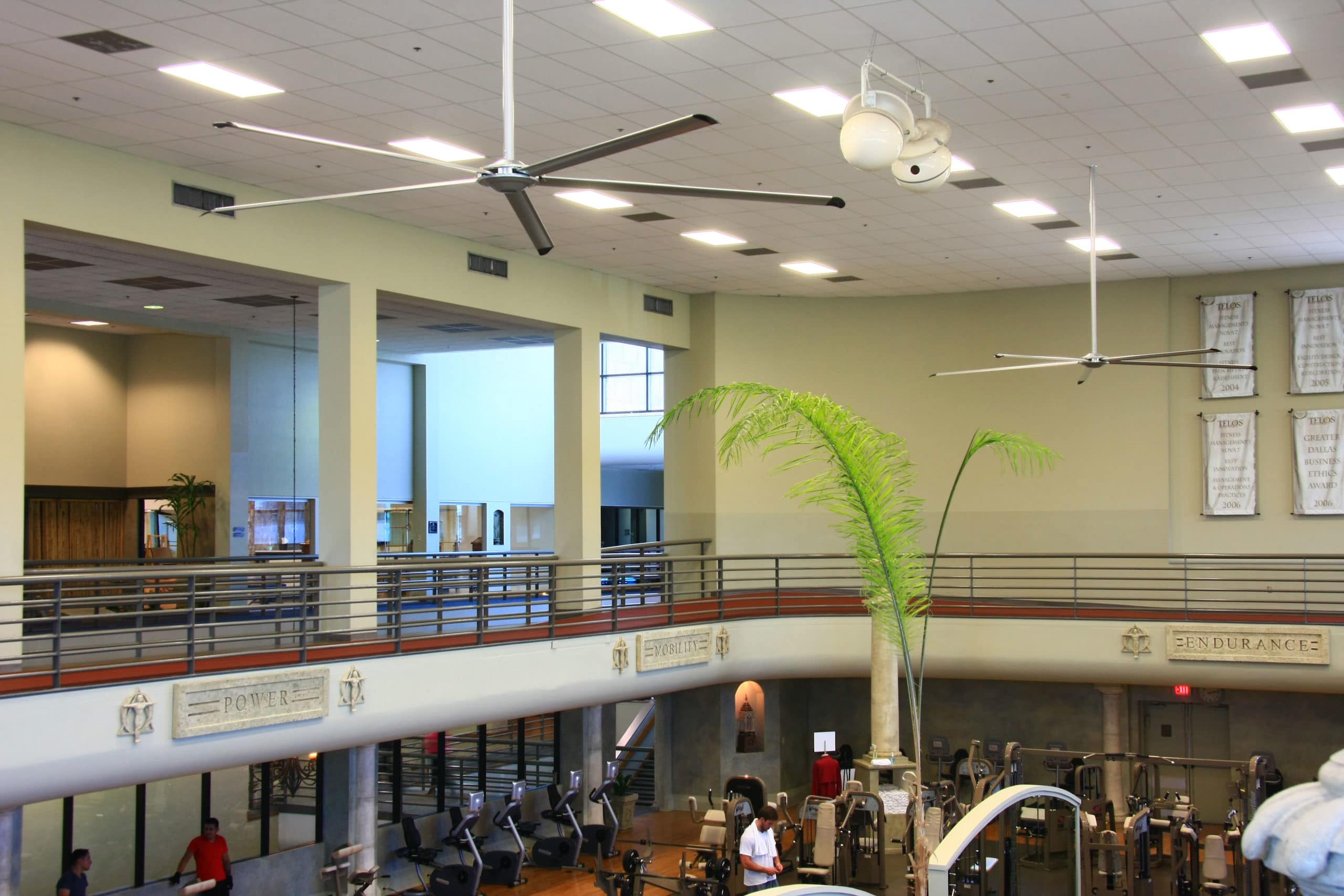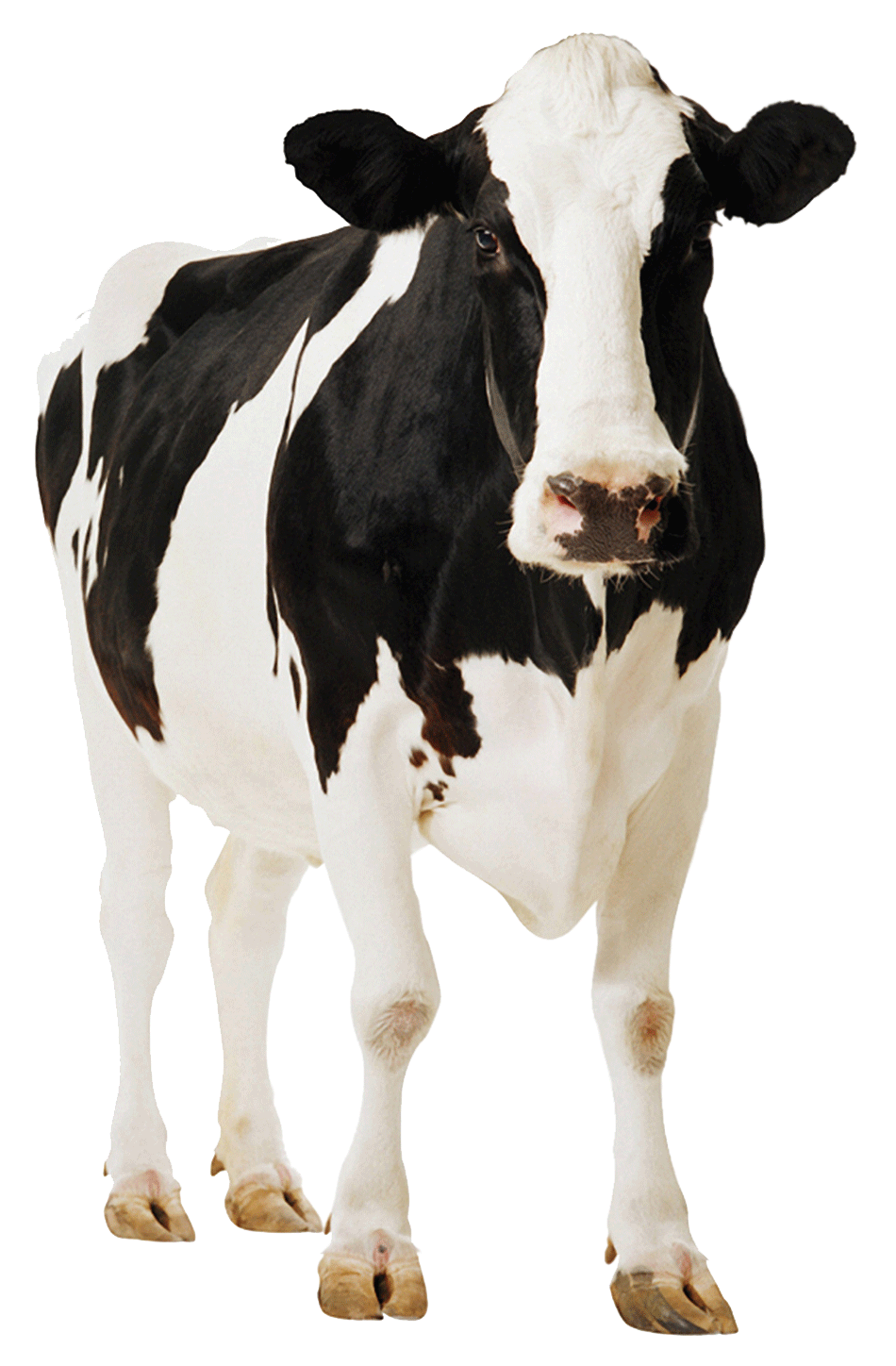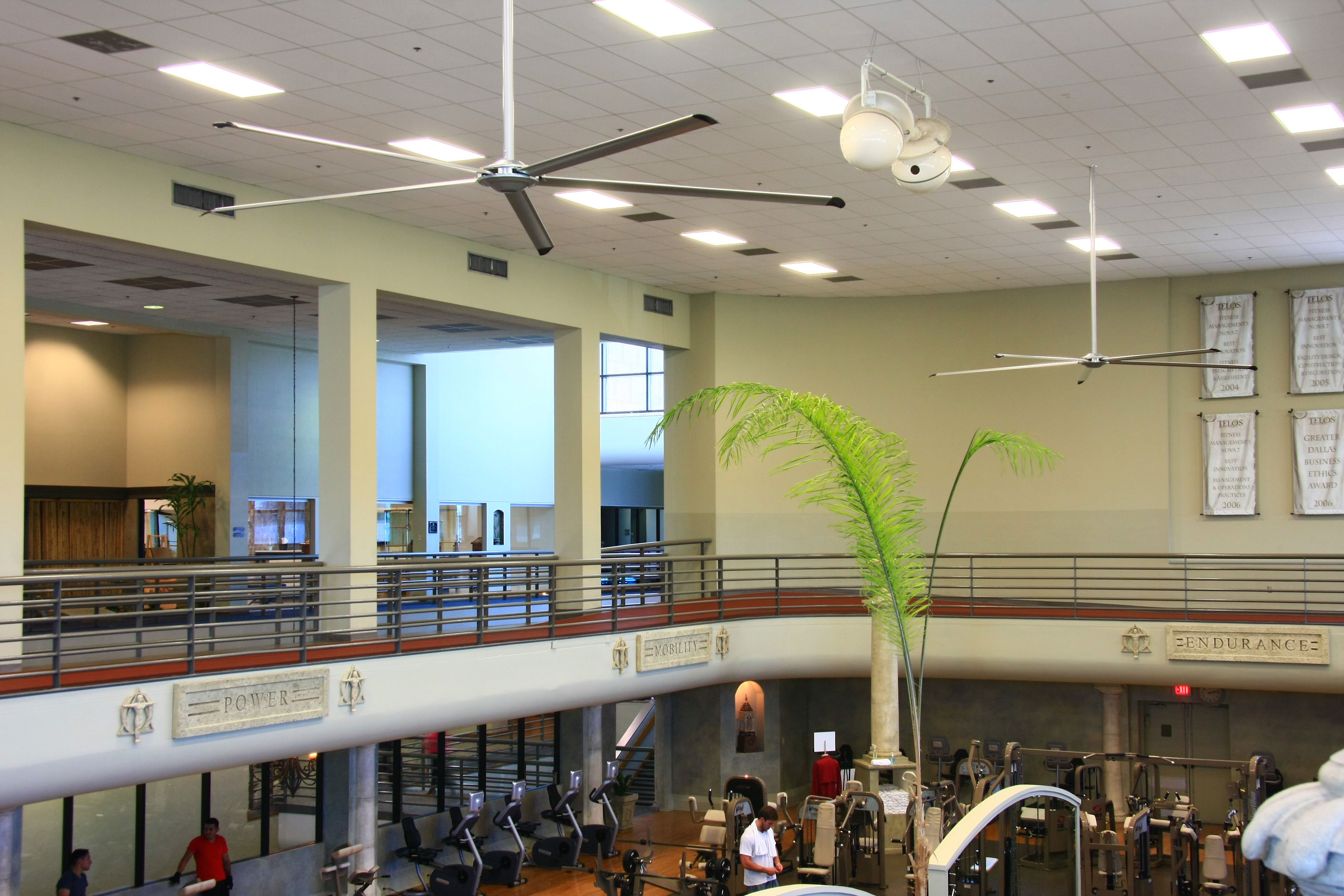
Entrematic’s large HVLS fans move enough air to keep the Telos Fitness Center in Dallas cool. [Photo: Courtesy of Entramatic]
Richard Hoofard sits in a large office lobby, chatting on the phone, glancing up at the large, quiet fan overhead. He’d almost forgotten it was even there, which is funny because, as the director of engineering for Entrematic, the company who made it, he knows precisely how it works.
“The thing about these fans is they’re very silent. Under normal operating you cannot hear them,” Hoofard says.
Hoofard works for Entrematic, the maker of the line of commercial HVLS (high-volume low-speed) fans you see more and more in restaurants, bars, office buildings, and even churches. If you notice the fans, at all, that is. They’re often designed to fit seamlessly into their surroundings, though they can be designed to fit in or stand out as much as you’d like, whether you want an all chrome or rustic wood style, among others.
Quiet and Cool
Entrematic’s C-Class commercial fans are an especially good fit for gyms, like the 66,000-square-foot Telos Fitness Center in Dallas, as the fans circulate large amounts of air with ease. “Everyone is in there sweating. It would get pretty stuffy without the fans,” says Mike Pope, director of facilities for the four-story luxury workout facility.
Two 14-foot fans overlook Telos’s two-story area with an open-air running track on top. Considering the center is in a 30-year-old building with equally old air conditioners, Pope says it needed a little help circulating air—especially on 100-degree Texas days. “From where the fans are to where the floor of the coliseum is is about 40 feet,” he says. A small fan couldn’t push enough air from the vents to the workout room below. Not to mention Telos has glass windows surrounding the track, drawing even more heat in. “That was one of the biggest needs—to find something that was able to push enough cool air down on top of the workout room,” he says.
Pope says the fans have cooled the space tremendously—they don’t even have to run at full speed. He says they’re also so quiet “you have no idea they’re even on.” But without them, you’d certainly notice. Since they’re virtually silent, you’ll also find Entrematic’s fans in locales like the Corsicana Opera House just south of Dallas as well as in churches and schools. “You don’t want to be able to hear the fans in schools, especially during test times,” Hoofard says. “Sound is a huge issue, and we designed this to be silent.”
You can find Entrematic’s fans anywhere from your standard office environment—like a lobby or large call center with rows upon rows of cubicles—to restaurants or more industrial areas like auto shops. They’re perfect when you want to cool a large group of people, but not overdo it.
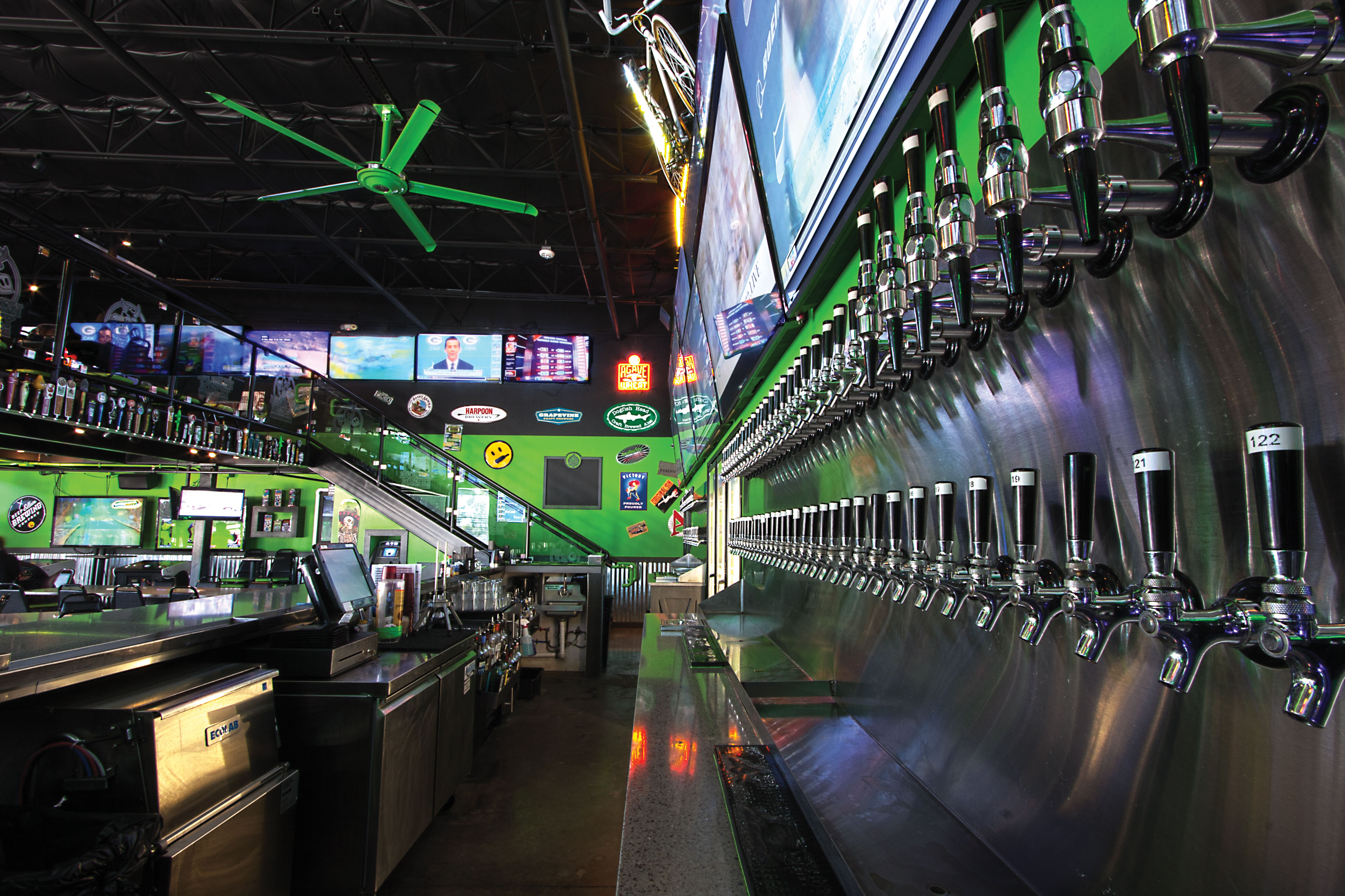
Entrematic’s large HVLS fans are quiet enough to keep restaurant and bar patrons happy and cool, too. [Photo: Courtesy of Entramatic]
DID YOU KNOW
HVLS fans were originally designed to cool livestock—hot cows don’t often produce the same amount of milk. And cows, like people, also don’t love strong breezes. The solution? The HVLS fan.
Working Together
The beauty of HVLS fans is how they work together with more traditional air conditioning, while preventing you from running the AC full blast and freezing people out. An HVLS fan allows you to meet that narrow comfort zone of an office environment. Just like you might at home, it lets you more casually control your temperature, set your thermostat a little higher, and use the fan to move air.
Plus, the HVLS fan is both gentler and more efficient than using air conditioning alone. While a desk fan puts out a narrowly focused, high volume stream of air, an HVLS fan with a larger blade set moves more air, and calmly. We’ve all experienced sitting by an AC vent that’s blowing out a large volume of cold air—it’s not pleasant. “No one ever wants to sit under an air conditioning vent because you freeze, or in the winter you bake,” Hoofard says.
Most offices also have just a couple of air conditioning vents per room, so a lot of air has to be forced from just two places. “The fan’s benefit is you don’t have to use that air conditioner as often,” Hoofard says. You don’t have to have a blast of cold air—you can simply have a steady stream of air, even if it’s slightly warmer, blowing across your skin. “We can move a large volume of air at slow speeds and improve the efficiency of the air conditioning system, reduce energy, and improve comfort. Most people like a little bit of airflow—no one likes stagnant air. What we do is provide the ability to generate that gentle airflow in large volumes.”
Looking up at the very fan that was spinning above him recently, Hoofard remarks on its efficiency. “Looking at the one in my lobby now, it’s turning at about 25% [of full power]. That’s all it requires.”
The fans work easily with other technology, as Entrematic fans can be networked into an overall building management system, EMS or DDC. This allows business owners to automate the speed of the fans, turn them off and on, or change the fan’s direction. It also eliminates your coworkers from fighting over the thermostat.
Three Degrees
If the fan is in the right place, you can increase your thermostat temperature by approximately three degrees, Hoofard says. In a harsh environment like Texas, that adds up to a lot of money saved over time. “From an energy use perspective, that’s huge,” he says. Entrematic used a comfort level generator, developed by ASHRAE (American Society of Heating, Refrigerating and Air-Conditioning Engineers) to calculate its fan’s design. “We developed our design to work within the office environment and to be optimal for efficiency and comfort,” Hoofard says.

Entrematic’s large HVLS fans featured in the Telos Fitness Center in Dallas. [Photo: Courtesy of Entramatic]
In Demand
As more and more people are learning about HVLS fans, demand increases. “HVLS fans didn’t exist before the year 2000. They’re a relatively recent invention,” Hoofard says, adding that they actually came about as a way to cool livestock in large dairy barns.
Hoofard says HVLS technology was originally geared toward the industrial side—in large warehouse environments, for example. Over time, that migrated to “Hey, what about moving them into the commercial side?” Enter Entrematic fans in big stores like Costco, restaurants, bars, churches, schools, and now offices. Some people even see the fans in offices and decide they want one for their house, especially those with large houses and vaulted ceilings. “We’re seeing some residential demand, not nearly what we’re seeing on the commercial side, but to me it’s a logical progression,” Hoofard says.
HVLS fans have come a long way since the beginning, and Entrematic’s risen to the top of the list. Pope has been in the construction industry for about 15 years and has seen similar companies—those who sell at big-box retailers—but says they aren’t as aesthetically pleasing as Entrematic’s. “They just didn’t look like what we wanted them to look like.”
Entrematic fans can be designed to look any way you want to match any environment. They also come in an array of colors, whether you want “starburst silver,” cobalt blue, “red baron,” or any other color. The choices are literally endless. The Telos team settled on two sleek, silver fans, installed in August 2016, and Pope says he couldn’t be more pleased. “We never have a shortage of cool air blowing now.
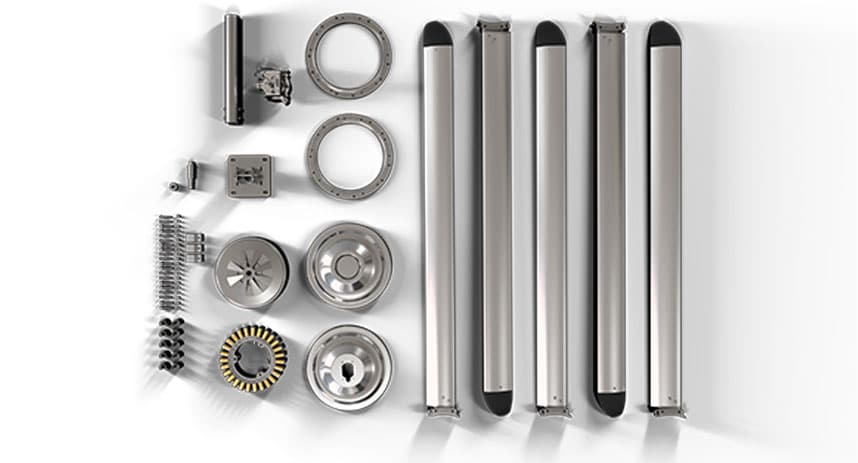
[Photo: Courtesy of Entramatic]
HOW IT WORKS
- 5 Blades: The five-blade design is built for low-speed rotary airfoil applications and a quieter experience
- Quick Installation: Blades snap into the hub through unique easy-to-install design
- Downturned Winglets: Promote airflow efficiency, funneling away turbulent air that can cause drag
- Versatile Mounting: Attach to wood ceilings, between roof trusses, and more
- Low-Profile Advantage: Optimizes airflow while accommodating lower ceilings
- Integrated Electronics: Integrated electronics and wireless remote functionality for easy operation
- Custom Powder-Coating: Color and designs powder-coated onto fan for a durable, high-quality finish
- Fire-Safe Shutdown: Connects with your building’s system to shut down during a fire

